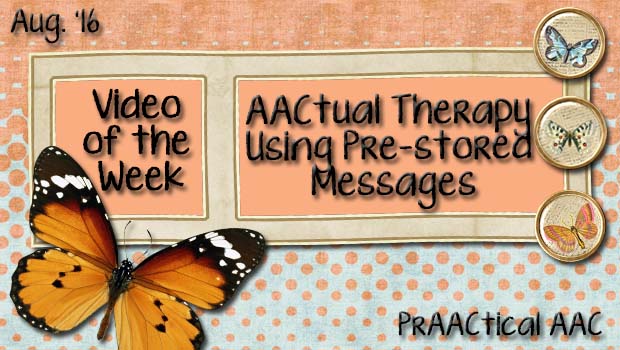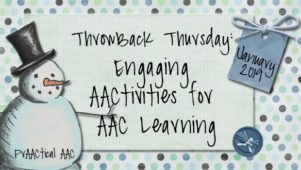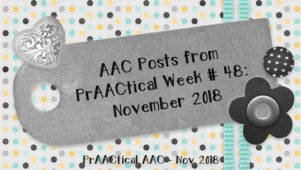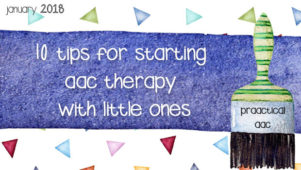Video of the Week: AACtual Therapy Using Pre-stored Messages

In the past few years, we’ve written a lot about the value of AAC systems that are rich in single core vocabulary words. Our position has always been, however, that many users of AAC will also benefit from fringe vocabulary words and selected prestored messages. You can read more about that here.
To be sure, pre-stored messages, including phrases, sentences, and full questions, have their drawbacks. The main downside relates to the lack of flexibility they offer. Once programmed into a device, the communicator has to use them just the way they are. If he/she wants to say a variation of that message, they are out of luck. In the context of a robust system, however, this isn’t as problematic as it sounds. Individuals who have been provided with robust AAC systems can go to their single word vocabulary to be more precise if the pre-stored message doesn’t capture exactly what they want to say.
Because they are faster and easier to use than assembling sentences word by word, pre-stored messages can make interaction more enjoyable for some AAC learners. In this week’s featured video, SLP Vicki Clarke, author of our AAC Assessment Corner series, lets us peek into a therapy session with a man who uses prestored messages for some of his communication needs. Take a look.
Direct Link to Video: https://www.youtube.com/watch?v=FgxhBSSDd_s
Filed under: Video of the Week
Tagged With: prestored messages, therapy
This post was written by Carole Zangari






3 Comments
Nicholas has worked on core vocabulary for 13 years. He always struggled getting past 2 or 3 consistent single words. He seems so satisfied with quick phrase based communication and now he’s beginning to combine his core words for the first time into familiar phrases. I think he’s worked a top down approach on me! I use both a core first approach and a phrase based approach, very much dependent on the individual patient. I prefer core first but some people need the to hear the full message match their intent first before they can deconstruct the language into individual words. Nicholas is one of those people. A delightful, interactive young man!
Thanks for that information, Vicki! Prestored messages can be GREAT way to get AAC learners interested in building new communicative habits. Because it is a little easier to use at first, they develop positive associations with using the AAC system and are eager to engage. That lets us move on and help them build more generative language skills. This is a great example of individualizing the AAC plan based on the needs and preferences of the people we serve. For some, starting with core and building generative language from the start is the way to go. Others may need a different path, and prestored messages can be a powerful tool in that journey.
That reminds me of the way some autistic children learn to talk. While most kids start by saying single words and then learn to make sentences, I’ve heard of several autistic kids who started with communicative echolalic phrases, and then learnt how to break them down into words.